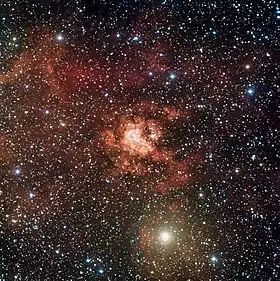| Observation data Epoch J2000 Equinox J2000 | |
|---|---|
| Constellation | Carina |
| Right ascension | 10h 25m 56.502s[1] |
| Declination | −57° 48′ 43.52″[1] |
| Apparent magnitude (V) | 12.661[2] |
| Characteristics | |
| Spectral type | O3/WN5ha + O3Vz((f*))[3] |
| B−V color index | +1.507[2] |
| Variable type | Eclipsing[4] |
| Astrometry | |
| Proper motion (μ) | RA: −4.079[1] mas/yr Dec.: 2.617[1] mas/yr |
| Parallax (π) | 0.2497 ± 0.0143 mas[1] |
| Distance | 13,100 ± 700 ly (4,000 ± 200 pc) |
| Absolute magnitude (MV) | −7.20[3] |
| Orbit[4] | |
| Primary | WR |
| Companion | O |
| Period (P) | 31.67855±0.00002 days |
| Semi-major axis (a) | 230 R☉[5] |
| Eccentricity (e) | 0.695±0.007 |
| Inclination (i) | 61.8±1.5° |
| Semi-amplitude (K1) (primary) | 158.0±2.7 km/s |
| Semi-amplitude (K2) (secondary) | 278.1±2.8 km/s |
| Details | |
| WR | |
| Mass | 94.4[4] M☉ |
| Radius | 23.3±1.6[4] R☉ |
| Luminosity | 1,510,000[4] L☉ |
| Surface gravity (log g) | 3.69[4] cgs |
| Temperature | 45,000[6] K |
| O | |
| Mass | 53.6[4] M☉ |
| Radius | 14.8±2.0[4] R☉ |
| Luminosity | 1,050,000[4] L☉ |
| Surface gravity (log g) | 3.81[4] cgs |
| Temperature | 50,680[6] K |
| Age | 1.5[3] Myr |
| Other designations | |
| Database references | |
| SIMBAD | data |
WR 21a is an eclipsing binary star in the constellation Carina. It includes one of the most massive known stars and is one of the most massive binaries.
WR 21a lies near the Westerlund 2 open cluster[7] and likely to be an ejected member.[8]
The distance of WR 21a was not definitively known until Gaia mission. There have been estimates from 2.85 kpc to around 8 kpc, with consequent uncertainties in the system luminosity. The larger distance was preferred because of consistency with the derived orbital parameters.[6][9]
Every 31 days and 16 hours the two stars in this system revolve around each other. The inclination of the orbit means that only very shallow eclipses are observed and the brightness dips by only about 0.05 magnitudes. There are also even smaller brightness variations attributed to the heartbeat effect where the closest passage of the stars in their eccentric orbits creates brightness changes as the two stars illuminate each other. There may also be tidally-excited oscillations producing further small variations.[4]
The colliding winds of the two stars produce extremely high temperatures and luminous x-ray emission.[5] The system is also bright at radio wavelengths.[6]
References
- 1 2 3 4 5 Vallenari, A.; et al. (Gaia collaboration) (2023). "Gaia Data Release 3. Summary of the content and survey properties". Astronomy and Astrophysics. 674: A1. arXiv:2208.00211. Bibcode:2023A&A...674A...1G. doi:10.1051/0004-6361/202243940. S2CID 244398875. Gaia DR3 record for this source at VizieR.
- 1 2 Zacharias, N.; Finch, C. T.; Girard, T. M.; Henden, A.; Bartlett, J. L.; Monet, D. G.; Zacharias, M. I. (2013). "The Fourth US Naval Observatory CCD Astrograph Catalog (UCAC4)". The Astronomical Journal. 145 (2): 44. arXiv:1212.6182. Bibcode:2013AJ....145...44Z. doi:10.1088/0004-6256/145/2/44. S2CID 119299381.
- 1 2 3 Tramper, F.; Sana, H.; Fitzsimons, N. E.; De Koter, A.; Kaper, L.; Mahy, L.; Moffat, A. (2016). "The mass of the very massive binary WR21a". Monthly Notices of the Royal Astronomical Society. 455 (2): 1275–1281. arXiv:1510.03609. Bibcode:2016MNRAS.455.1275T. doi:10.1093/mnras/stv2373. S2CID 44364798.
- 1 2 3 4 5 6 7 8 9 10 11 Barbá, Rodolfo H.; Gamen, Roberto C.; Martín-Ravelo, Pablo; Arias, Julia I.; Morrell, Nidia I. (2022). "The winking eye of a very massive star: WR 21a revealed as an eclipsing binary by TESS". Monthly Notices of the Royal Astronomical Society. 516 (1): 1149. arXiv:2109.06311. Bibcode:2022MNRAS.516.1149B. doi:10.1093/mnras/stac2173.
- 1 2 Gosset, Eric; Naze, Yael (2016). "The X-ray light curve of the massive colliding wind Wolf-Rayet + O binary WR21a". Astronomy & Astrophysics. 1604: A113. arXiv:1604.01536. Bibcode:2016A&A...590A.113G. doi:10.1051/0004-6361/201527051. S2CID 119183652.
- 1 2 3 4 Benaglia, P.; Romero, G. E.; Koribalski, B.; Pollock, A. M. T. (2005). "Multiwavelength studies of WR 21a and its surroundings". Astronomy and Astrophysics. 440 (2): 743–750. arXiv:astro-ph/0506363. Bibcode:2005A&A...440..743B. doi:10.1051/0004-6361:20042617. S2CID 17048378.
- ↑ Hur, Hyeonoh; Park, Byeong-Gon; Sung, Hwankyung; Bessell, Michael S.; Lim, Beomdu; Chun, Moo-Young; Sohn, Sangmo Tony (2015). "Reddening, distance, and stellar content of the young open cluster Westerlund 2". Monthly Notices of the Royal Astronomical Society. 446 (4): 3797–3819. arXiv:1411.0879. Bibcode:2015MNRAS.446.3797H. doi:10.1093/mnras/stu2329. S2CID 119221719.
- ↑ Maíz Apellániz, J.; Crespo Bellido, P.; Barbá, R. H.; Fernández Aranda, R.; Sota, A. (2020), "The Villafranca catalog of Galactic OB groups", Astronomy & Astrophysics, 643: A138, arXiv:2009.05773, doi:10.1051/0004-6361/202038228, S2CID 221655188
- ↑ Carraro, G.; Turner, D.; Majaess, D.; Baume, G. (2013). "The distance to the young open cluster Westerlund 2". Astronomy & Astrophysics. 555: A50. arXiv:1305.4309. Bibcode:2013A&A...555A..50C. doi:10.1051/0004-6361/201321421. S2CID 53756444.
